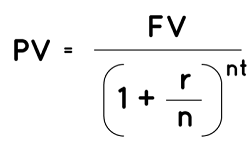Present Value Formula
The present value formula is a method of discounting future cash flows to arrive at their present-day value using the time value of money. The present value formula is made up of the present and future value of compound interest. The starting amount is the present value, or PV (the amount invested, the amount lent, the amount borrowed, etc). The final sum is the future value, or FV. FV = PV Plus interest, for example.
The present value (PV) formula is used in finance to determine the present value of a sum received at a later period. The compound interest formula is used to create the present value formula (PV formula). The formula for compound interest is: You can get all Maths formulas on one-page visit the Maths Formulas section of HT.
FV = PV (1 + r / n)nt
Dividing boththe sides by (1 + r / n)nt,
PV = FV / (1 + r / n)nt
Thus, present value formula is:
PV = FV / (1 + r / n)nt
Where,
- Present value = PV
- Future value = FV
- Rate of interest (percentage ÷ 100) = r
- Number of times amount is compounding = n
- Time in years = t
The number of times amount is compounded determines the value of n
- n = 1, if amount is compounded yearly.
- n = 2, if amount is compounded half-yearly.
- n = 4, if amount is compounded quart-yearly.
- n = 12, if amount is compounded monthly.
- n = 52, if amount is compounded weekly.
- n = 365, if amount is compounded daily.
